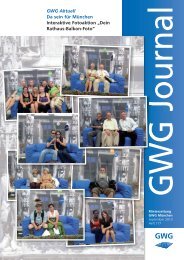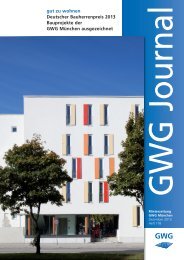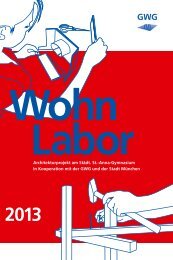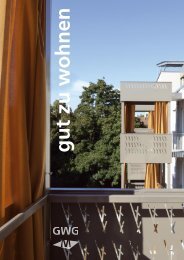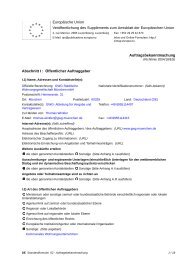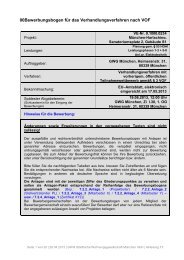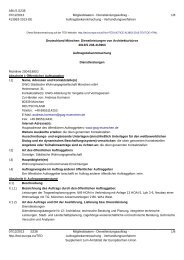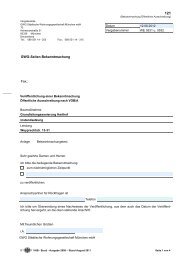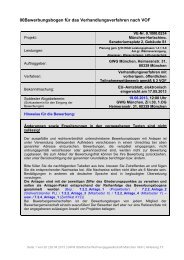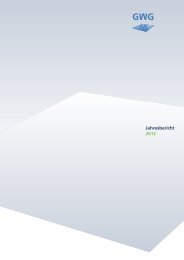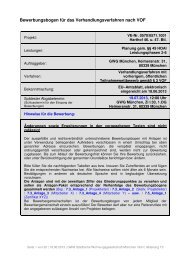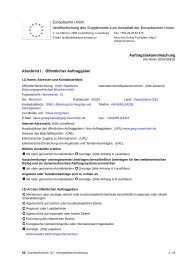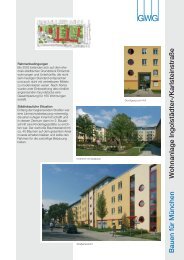New build - GWG München
New build - GWG München
New build - GWG München
Create successful ePaper yourself
Turn your PDF publications into a flip-book with our unique Google optimized e-Paper software.
Renovation as a service to<br />
the city:<br />
The role of <strong>GWG</strong> <strong>München</strong><br />
In 1918, before the First World War was over, the State Capital<br />
of Munich took the forward-looking step of establishing the<br />
Gemeinnützige Wohnstätten- und Siedlungsgesellschaft mbH<br />
(<strong>GWG</strong> <strong>München</strong>). There was a need for thousands of new<br />
apartments and a severe shortage of affordable living space.<br />
In its founding statutes, the new housing association undertook<br />
to ensure the “construction of apartments, especially<br />
small, healthy and affordable apartments for low-income inhabitants<br />
and members of the middle classes, with particular<br />
preference to large families”. Nearly 100 years later, this remains<br />
one of <strong>GWG</strong>’s main endeavours. In 1978, city councillor<br />
and general manager Hans Preißinger wrote in the commemorative<br />
publication marking <strong>GWG</strong>’s sixtieth anniversary that the<br />
main emphasis was on its socio-political mandate rather than<br />
economic success. Yet he also emphasised the importance of<br />
a solid financial base. Little has changed since the original<br />
objectives were first formulated in 1918. The company is still<br />
engaged in “providing, in a socially responsible manner, safe<br />
places for broad sections of the population to live in.”<br />
<strong>GWG</strong> <strong>München</strong> now has around 26,800 residential and commercial<br />
units on its books. Open spaces are a rare commodity<br />
in Munich. Buildings are a mirror of their times, especially with<br />
regard to their amenities. Just a quick look at the development<br />
of apartment sizes since the Second World War is enough to<br />
illustrate the trend of social change. While in 1950, a fourroom<br />
apartment had 48 square metres, a typical size for 2010<br />
is more than double, at 99 square metres. The trend among<br />
two-room apartments is not quite as drastic, but their sizes still<br />
grew from 35 square metres in 1950 to 55 square metres in<br />
2010.<br />
Expectations have risen too. When the first major <strong>GWG</strong><br />
<strong>München</strong> modernisation programme was drawn up in 1977,<br />
the objective was to raise the quality of 336 residential units to<br />
contemporary standards. In particular, this meant replacing or<br />
reinforcing electrical installations, and installing bathrooms<br />
and central heating with a hot water supply, as well as replacing<br />
windows and constructing balconies, to name just a few<br />
of the basic measures. 1978 marked another milestone in<br />
<strong>GWG</strong>’s modernisation and renovation activities. The newly<br />
drawn up “Overall Concept for the Sustained Improvement of<br />
Rented Housing Ownership” categorised 4,600 of the apartments<br />
owned by <strong>GWG</strong> <strong>München</strong> as requiring renovation and<br />
a further 6,100 as in need of modernisation. Renovation often<br />
entailed transforming a large number of small units into a<br />
small number of larger ones: where no economic alternative<br />
was available, the only choice was to demolish and re<strong>build</strong>.<br />
14<br />
In 1992 the city council initiated the “Second programme<br />
of sustainable improvement of <strong>GWG</strong> rental apartments by<br />
modernisation, major repair and attic conversion” (GMP):<br />
As a result, <strong>GWG</strong> undertook a programme of fundamental<br />
modernisation for its properties.<br />
An essential element of these large-scale modernisation activities<br />
is the intense care and assistance that <strong>GWG</strong> <strong>München</strong><br />
gives its tenants. Every occupant who has to move out due to<br />
modernisation or demolition and re<strong>build</strong>ing measures is informed<br />
in good time of offers for substitute accommodation,<br />
to ensure that nobody is "left out in the cold", in the words of<br />
<strong>GWG</strong> general manager Hans-Otto Kraus. A special team was<br />
put together to accompany and advise tenants right the way<br />
through the process. Every tenant who has to move may<br />
“move back to his familiar environment once the modernisation<br />
is complete, if he so wishes,” says Hans-Otto Kraus. In<br />
this way, <strong>GWG</strong> <strong>München</strong> is “not only preserving the identity<br />
of the neighbourhood through its <strong>build</strong>ings but also preserving<br />
the neighbourhood of its inhabitants.”



